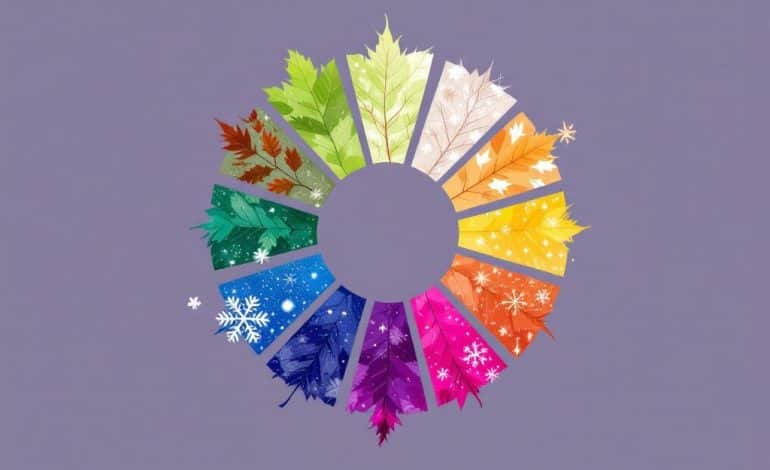
Hey there! So, have you ever wondered why your favorite brand suddenly switches to a totally different color palette just when you’re getting used to their current one? You’re not alone. It’s one of those things that can be as puzzling as it is ubiquitous. The need to adapt with the seasons is as essential to branding as a solid logo. Change is more than just a buzzword; it’s the essence of staying fresh and relevant in a whirlwind world. We’re talking about the big transition — “Season Change” in brand colors.
Understanding the Impact of Season Change on Branding
The entire world runs on seasons, and just like nature, businesses experience their cycles. Brands are tuning in more and more to the vibes of each season, altering their visuals to resonate with customers’ moods and experiences. As autumn rolls in with its warm hues, or spring bursts forth with pastels, so too do brands tweak their colors to stay in sync.
Here’s the thing—stemmed firmly in psychology, this is not just a mere ‘change for change’s sake’ effort. Colors have the uncanny ability to stir emotions, attract attention, and even rejuvenate brand identity. It’s about connection and creating a visual dialogue that feels timely and relevant.
Why Do Brands Change Colors with the Seasons?
Before we dive into how you can manage these colorful transitions yourself, let’s explore why brands bother switching things up at all.
- Adapting to Consumer Moods: Different seasons evoke different emotions. Bright, sunny colors in the summer can be inviting and fun, tapping into the energetic vibes of long days and open beaches. In contrast, cooler tones or warmer, richer hues for winter allude to coziness and tranquility. Brands play into these emotional cues to maintain that sensory connect.
- Cultural and Environmental Alignment: Consider how holidays and cultural events interweave with certain color choices. Red and green for festive times, earthy palettes around the autumn harvest — these aren’t just traditions; they’re expectations.
- Freshness and Relatability: People get bored—fast. You gotta keep things interesting! Updating your color scheme when the world around you is changing can signal your brand’s vibrancy and forward-thinking nature.
Making the Color Transition: Practical Advice

Alright, you get why. Now, how do you execute a seamless transition without creating chaos for your brand and its followers? Here’s the fun part—taking actionable steps. Let’s get into it.
Step 1: Evaluate Your Audience and Purpose
Before diving headfirst into a new tank of paint, ask yourself: who are you speaking to, and what’s the message? Honestly, the same color shift isn’t going to hit home with everybody, and an array of underlying factors might guide your choice.
- Audience Analysis: Age, location, culture — these can greatly influence how your change is received. Young, bold, energetic faces might embrace a vivid, striking palette, while a more refined crowd might appreciate subtler, muted hues.
- Core Brand Values: Stay rooted. Don’t make a change that betrays your brand’s essence. If you’re eco-friendly—lean into greens and earthy impacts; if you’re technological, maybe a high-tech blue-and-silver shift?
Step 2: Gather Inspiration and Seasonal Trends
A no-brainer—knowing what’s trending can inject a fresh breath into your seasonal color change. But this isn’t about feeling chased by trends—use them as a trampoline, not a cage!
- Mood Boards: Create, collaborate, and consult those idea pockets. Combine seasonal themes and your brand’s unique voice to visualize the possibilities.
- Fashion and Design Insights: Staying attuned to the broader scope of fashion and interior design trends can offer valuable insights into color trends foretelling shifts in cultural moods.
Step 3: Experiment Before the Launch

You’ve got your audience, your ideas, and now you’re ready to—slow it down a bit! Jumping without a parachute in any area of business is a dicey proposition. Testing is your newfound best friend.
- A/B Testing: Roll out small experiments with subsets of your audience. Be it through social media channels, or targeted email campaigns, give people a taste-testing experience with the varied color options.
- Feedback Mechanism: Get ready to engage—initiate conversations around the proposed changes. Pose open-ended questions and genuinely consider responses.
Success Stories and Lessons from Those Who’ve Mastered the Change
Drawing on real-world examples is a fantastic way to inspire and guide your approach. Let’s look at some successes and even hiccups experienced by brands navigating seasonal color changes.
Coca-Cola: Festive Red at Its Best
Globally iconic brands like Coca-Cola master the art of seasonal adaptations. They maintain their signature red—a hero color—but augment with festive iconography during the holiday season, evoking warmth, family, and tradition.
Starbucks: From Autumn Leaves to Spring Blossoms
Starbucks does an impeccable job with seasonal changes by simply altering cup designs or including launches around particular seasonal flavors. Colors effectively work hand-in-hand with their products.
Where It Can Occasionally Go Wrong
A word of caution—be mindful of overwhelming your base. There have been notable instances where brands went too far astray from their recognized palette, creating disconnect and confusion. Keeping a semblance of the familiar amidst an infusion of the new is the delicate balance one must walk.

Tools and Resources to Help on This Journey
We’ve talked over the “what” and “why” — but the “how” carries some equally cool weight. Thankfully, in this digital age, you’ve got tools lining up to ease the transition:
- Color Scheme Designers: Online utilities like Adobe Color or Coolors can aid in creating visually balanced color palettes. Align these with seasonal inspirations and see them transform your branding.
- Data Analytics Tools: Platforms like Google Analytics or social media insights can help understand what color schemes previously garnered positive engagements.
- Graphic Design Software: Leverage options such as Canva or Photoshop for simulating how new colors play out across marketing collateral under a unified style scheme.
Wrapping It Up: Revisiting the Essentials of Adjusting Brand Colors Seasonally
As we meander to the end, let’s do a quick flashback.
- Seasons influence emotions, and brands can tap into this cycle by shifting colors. Understand your audience and what emotional landscape they roam.
- Evaluate and experiment through proactive steps. Developing a color guide rooted in your identity and trying these colors in real scenarios ensures you don’t venture too far afield.
- Keep dialogues open with your audience and remain in the loop with industry trends. Discern trend-setters from trend-followers constantly.
Adapting a brand’s presence to the different seasons isn’t an instant coffee trick. It requires patience, intent, and a propensity to both withstand challenges and embrace change. By swirling arrogance aside and armed with insights and creativity, every season change becomes a vibrant opportunity for growing your brand’s reach and resonance. Go ahead, lean into those seasons, and trust the colors to tell the story!
Frequently Asked Questions
What causes the change in seasons?
The change in seasons is caused by the Earth’s axial tilt as it orbits the Sun. The Earth’s axis is tilted about 23.5 degrees, which results in different parts of the planet receiving varying amounts of sunlight throughout the year. This tilt leads to the seasons, with the Northern Hemisphere receiving more direct sunlight during its summer and less during its winter, and vice versa for the Southern Hemisphere[1][3][5>.
How are the seasons defined and when do they begin?
The seasons are typically defined by four periods: spring, summer, autumn (or fall), and winter. These seasons can be marked by astronomical dates or meteorological definitions. Astronomically, summer begins on the summer solstice (June 21/22 in the Northern Hemisphere and December 21/22 in the Southern Hemisphere), winter on the winter solstice, spring on the vernal equinox, and autumn on the autumnal equinox. Meteorologically, the seasons are defined by temperature, with summer starting on June 1, autumn on September 1, winter on December 1, and spring on March 1 in the Northern Hemisphere, and the opposite dates for the Southern Hemisphere[1][3][5>.
How do the seasons affect different regions on Earth?
The impact of the seasons varies significantly depending on the region. Near the Equator, there is little seasonal variation in temperature, but there may be rainy or dry periods. In temperate and polar regions, the seasons are more pronounced, with cold winters and warm summers. The North and South poles experience extreme conditions, with constant cold and periods of complete daylight or darkness during their respective summers and winters[1][3][5>.
Will the seasons always remain the same?
No, the seasons will not always remain the same due to the precession of the Earth’s axis. Precession is a slow circular motion of the Earth’s tilted axis, similar to a top’s wobble, which takes about 26,000 years to complete. This process affects the timing of the seasons and the position of the celestial poles, introducing small irregularities over long periods[5>.
References






